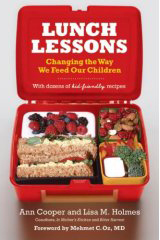
Children were in the news this week.
George Bush, while draining the treasury to fund his ghastly war-without-end, announced he would refuse to expand health insurance for the nation's kids.
Atta boy, George. Show 'em you know how to save where it counts.
Meanwhile, a new study published recently in the British medical journal
The Lancet, and described
in some depth by
The New York Times, finds that food additives do in fact cause hyperactivity in children. Seems to me I had cousins 40 years ago who had to restrict their intake of
Red Dye No. 2 and other additives for the very same reason.
Plus ca change....
The study followed three sets of children--aged 3, 8 and 9--for six weeks, giving them drinks with artificial colors and food additives such as
sodium benzoate. A control group was given drinks that looked the same but did not contain the additives.
The children who consumed the additives were then evaluated by parents, teachers and computer tests. The results? The kids who ate the nasty stuff showed signs of hyperactivity within a half-hour of consumption.
Researchers say some children are more sensitive than others, and there are undoubtedly other factors at work in children who are
hyperactive. But food additives are one thing parents concerned about hyperactivity can control by eliminating them from the diet.
Fresh fruits and vegetables, anyone?
*****
And just when you thought your kid was safe from those horrible soft drinks in the school vending machine,
Coke, Pepsi and the other big bottlers are fighting to keep sports drinks such as
Gatorade out of proposed new federal legislation aimed at setting nutritional standards for schools.
Legislation
introduced in the U.S. Senate would establish standards for foods sold outside school cafeterias. In the past, that would have meant all those soft drinks made primarily from high fructose corn syrup sold in vending machines. Having pledged to phase out full-calorie drinks from schools by 2009, the big bottlers have switched gears and are now heavily promoting their sports drinks, which are lighter on the corn syrup but high on the sodium.
Gatorade Rain, for instance, although it has only half the calories of Coke, contains twice as much sodium. A 20-ounce bottle contains fully 12 percent of the recommended daily amount for a child
aged 14-18.
The
Institute of Medicine in April released a report urging that sports drinks be made available in schools only to student-athletes participating in more than one hour of vigorous activity. And a report from the
University of California at Berkeley's Robert C. and Veronica Atkins Center for Weight and Health warned that students who drink one 20-ounce sports drink every day for a year are liable to gain about 13 pounds.
Some health experts believe sodium may be the deadliest ingredient of all in the U.S. food supply.
*****
Junk food by any other name?
Some jurisdictions have mandated healthier foods in their schools. But an
in-depth look by the
San Francisco Chronicle finds that schools in
California do not adhere equally to the law's mandates, and that often what the kids are getting is just reformulated junk food.
One school kiosk is selling potato chips, another
Cheetos, another chocolate chip cookies. Some schools are ignoring the new law altogether, while others allow kids to make a meal of revamped snacks.
According to the
Chronicle, in the last year more than 10,000 products have been either introduced or reformulated to contain less fat and sugar. Now, snacks such as
Nutter Butters, Rice Krispies Treats, nacho-flavored
Baked Doritos and barbecue
Corn Nuts comply with the school nutrition standards. They may comply with the letter of the law, but the Chronicle asks, do they comply with the spirit in which the law was passed?
Meanwhile, essayist
Tom Philpott describes the disaster that school lunches have become in most U.S. localities. Some school districts are squeezing the lunch hour, forcing kids to finish their meals 20 minutes. Others have stopped making food from scratch and instead have food trucked in and reheated, so that lunch means pealing plastic seals off plastic dinnerware, as well as from plastic eating utensils and plastic condiments. Elsewhere, schools are enacting "user fees," forcing kids and their parents to pay for meals.
"The
de facto privatization of school lunches amounts to a society-wide divestment in children’s health,"
Philpott writes. "At this point, the
statistics hardly need repeating: Nearly one in six children and teens are overweight, and diet-related (Type II) diabetes — until recently rare in children — is reaching epidemic levels.
"The money we’re saving by slashing school-lunch budgets will eventually be paid to the health-care industry, with interest."
****
Are children who eat organic cereal for breakfast missing out on their vitamins? A
recent piece in the
New York Times would have us believe so.
Parents choose organic cereals precisely because they are free of food colorings and other additives. But according to the Times, those healthy cereals are missing the vitamins that conventional cereal makers add to their products.
Critics contend that the Times coverage completely missed the debate over whether those
artificially-added vitamins are processed by the body in the same way as naturally occurring vitamins, or whether children shouldn't be getting their vitamins from fresh fruits and whole milk.
But here's another question: Do you really buy your kids cereal for the vitamins?
******
Food dyes and other additives represent just the tip of the ice berg when it comes to dubious ingredients in processed foods. But how do we teach children to recognize the bad things in commercial products and perhaps steer them toward healthier foods in the process?
A few programs popping up around the country are teaching children to read and comprehend food nutrition labels. A program in
Seattle, for instance, the
Pure Food Kids Workshop, takes kids through a 2 1/2-hour seminar showing them how they are marketed to by the big food conglomerates, the difference between whole and processed foods, the possible ill effects of food additives and how to recognize ingredients by reading nutrition
labels.
In
Vermont, a program called
Reinventing the Meal encourages children to be more curious about what's in their food, where it comes from and how many miles it travels before it arrives on their dinner plate. And
Harvard University sponsors
Planet Health, which incorporates exercise and diet choices to develop healthier lifestyles.
******
Kids love to make microwave popcorn. And their parents love it too, its so convenient. So it came as quite a shock to learn that the chemical ingredient used to impart that buttery flavor in microwave popcorn can cause a deadly lung disease.
Some manufacturers have recently agreed to remove the chemical.
Legislation passed by the
U.S. House of Representatives would order the
Occupational Health and Safety Administration (OSHA) to limit exposure to the chemical
diacetyl, which has been linked to the so-called
"popcorn lung" disease in popcorn plant workers.
Or, how about just making popcorn the old fashioned way--on the stove...
 We spent part of the afternoon today at a crafts fair sponsored by the local City Paper and dubbed "Crafty Bastards." There were more than 100 booths packed into an area outside the Marie-Reed recreation center in Adams-Morgan and the place was jammed. Lots of handmade stuff--several different vendors of fancifull stuffed monsters made from cotton and/or recycled cloth. Near the Italian ice stand was this New Orleans jazz band playing up a storm.
We spent part of the afternoon today at a crafts fair sponsored by the local City Paper and dubbed "Crafty Bastards." There were more than 100 booths packed into an area outside the Marie-Reed recreation center in Adams-Morgan and the place was jammed. Lots of handmade stuff--several different vendors of fancifull stuffed monsters made from cotton and/or recycled cloth. Near the Italian ice stand was this New Orleans jazz band playing up a storm. Audience participation was encouraged. If you look closely, you can see a certain farmer guy in his straw hat and New Orleans Jazz Fest shirt workin' the washboard.
Audience participation was encouraged. If you look closely, you can see a certain farmer guy in his straw hat and New Orleans Jazz Fest shirt workin' the washboard. There was a beat you could dance to....
There was a beat you could dance to.... And the trombonist was some kind of cool.
And the trombonist was some kind of cool.









































